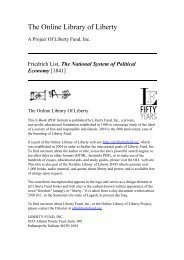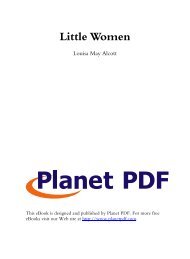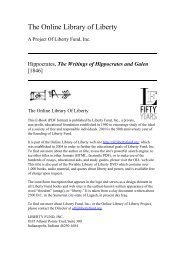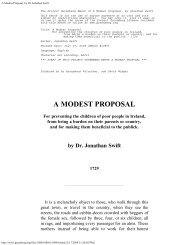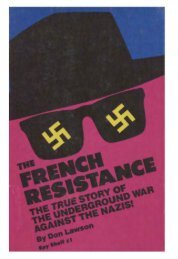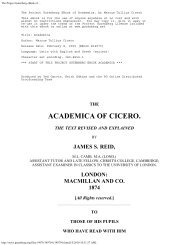From Farm House to the White House - 912 Freedom Library
From Farm House to the White House - 912 Freedom Library
From Farm House to the White House - 912 Freedom Library
You also want an ePaper? Increase the reach of your titles
YUMPU automatically turns print PDFs into web optimized ePapers that Google loves.
<strong>Farm</strong> <strong>House</strong> <strong>to</strong> <strong>the</strong> <strong>White</strong> <strong>House</strong>, by William M. Thayer 119<br />
"A large Virginia estate in those days was a little empire," he says. "The mansion-house was <strong>the</strong> seat of<br />
government, with its numerous dependencies, such as kitchens, smoke-house, work-shops, and stables. In this<br />
mansion <strong>the</strong> planter moved supreme; his steward, or overseer, was his prime minister and executive officer; he<br />
had his legion of house negroes for domestic service, and his host of field negroes for <strong>the</strong> culture of <strong>to</strong>bacco,<br />
Indian corn, and o<strong>the</strong>r crops, and for o<strong>the</strong>r out-of-door labor. Their quarter formed a kind of hamlet apart,<br />
composed of various huts, with little gardens and poultry yards, all well s<strong>to</strong>cked, and swarms of little negroes<br />
gambolling in <strong>the</strong> sunshine. Then <strong>the</strong>re were large wooden edifices for curing <strong>to</strong>bacco, <strong>the</strong> staple and most<br />
profitable production, and mills for grinding wheat and Indian corn, of which large fields were cultivated for<br />
<strong>the</strong> supply of <strong>the</strong> family and <strong>the</strong> maintenance of <strong>the</strong> negroes."<br />
At <strong>the</strong> same time that Mrs. Washing<strong>to</strong>n had <strong>to</strong> preside over <strong>the</strong> farm-house for <strong>the</strong> sake of <strong>the</strong> one thousand<br />
souls on <strong>the</strong> large estate, she was obliged <strong>to</strong> conduct her domestic affairs in a costly and fashionable way for<br />
<strong>the</strong> sake of her guests. Her wardrobe, furniture, and preparations for special occasions were necessarily<br />
elaborate and expensive, for her mansion was <strong>the</strong> resort of <strong>the</strong> most distinguished men and women of <strong>the</strong><br />
country. Almost every day some civil or military gentleman of distinction was found at her table. Hence,<br />
much style and expense were required <strong>to</strong> maintain her hospitable board. A silver service was demanded by <strong>the</strong><br />
times, <strong>the</strong> manners and cus<strong>to</strong>ms of which were imported from England. All o<strong>the</strong>r appointments corresponded<br />
with this royal standard. Irving says that Washing<strong>to</strong>n's "intimacy with <strong>the</strong> Fairfaxes and his intercourse with<br />
British officers of rank had <strong>the</strong>ir influence on his mode of living."<br />
Mrs. Washing<strong>to</strong>n had her chariot and four, with driver and black postilion in livery, more, perhaps, <strong>to</strong><br />
entertain and honor her distinguished guests than for personal enjoyment. Her husband usually appeared on<br />
horseback. He loved horses, especially fine ones, and most of those in his stables were imported. To each he<br />
gave a name, suggested by some quality that attracted his observant eye, as Ajax, Blueskin, Valiant, Magnolia<br />
(Arabian), etc. Several noble dogs for fox-hunting were found about his house and stable--Vulcan, Singer,<br />
Ringwood, Sweetlips, Forrester, Music, Rockwood and Truelove. With such preparations, an English baronet<br />
and his wife, Lord Fairfax, <strong>the</strong> wealthy fox-hunter, provincial governors and generals, or <strong>the</strong> ordinary farmer,<br />
could all be accommodated on <strong>the</strong> Mount Vernon estate.<br />
An order sent <strong>to</strong> England in 1759 shows that Mrs. Washing<strong>to</strong>n's wardrobe received particular attention:<br />
"A salmon-colored Tabby (velvet), with satin flowers for sack and coat.<br />
"One cap, handkerchief and tucker and ruffles, <strong>to</strong> be made of Brussels lace or Point, proper <strong>to</strong> be worn with<br />
<strong>the</strong> above; <strong>to</strong> cost £20 (one hundred dollars).<br />
"Two fine flowered lawn aprons.<br />
"Two pairs women's white silk hose.<br />
"Six pairs fine cot<strong>to</strong>n do.<br />
"Six pairs thread do., four threaded.<br />
"One pair black and one pair white satin shoes of <strong>the</strong> smallest fives.<br />
"Four pairs Calimanco do.<br />
"One fashionable hat or bonnet.<br />
"Six pairs women's best kid gloves.





